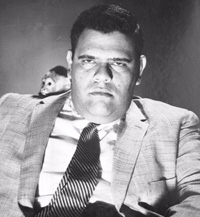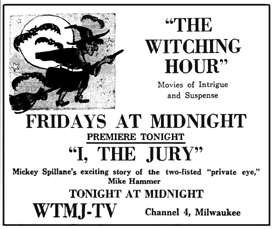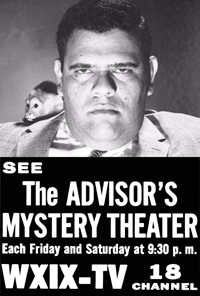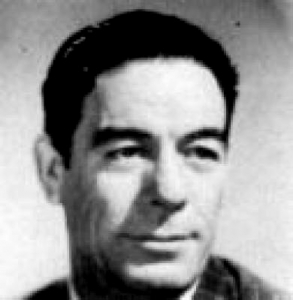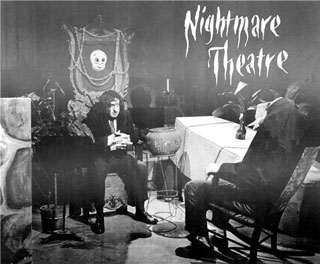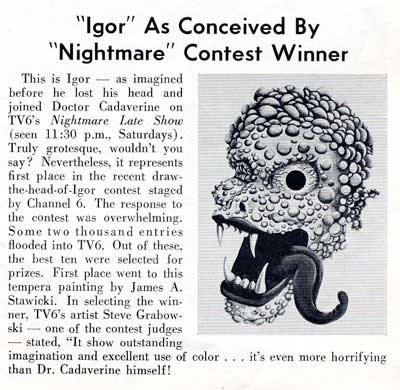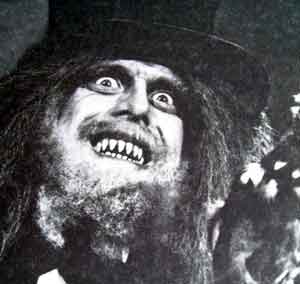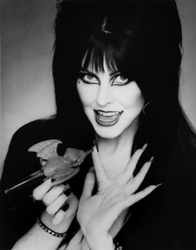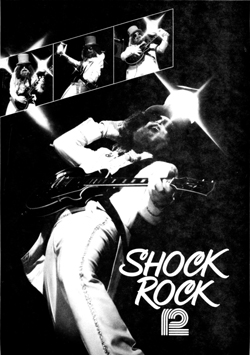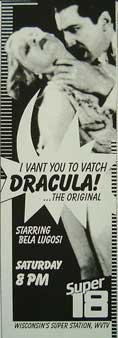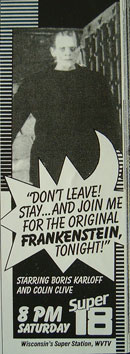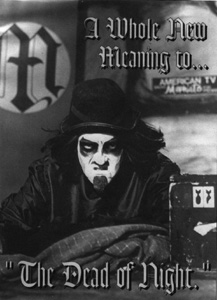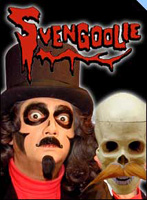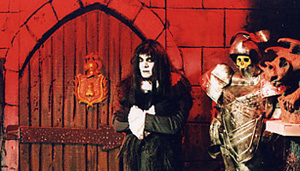Important Info:WI Horror Host historian Dick Golembiewski has passed away.Much of the original pictures and videos may be lost/missing. If you have old content/missing info to add to this site, please email info@milwaukeehorrorhosts.com To play the audio files on this site, you'll need Early television stations needed programming. Since syndicated shows were not available in the same quantities they are now, local stations produced their own, which covered the gamut from kiddie fare to serious drama. In the early 1950s, most television shows were live, as there was no convenient way to produce them in advance. Film was expensive. (Copies of shows from the late 1940s and early-to-mid 1950s were made on kinescopes — a process which involved pointing a 16mm movie camera at a television monitor.) It wasn't until April of 1956 that Ampex demonstrated the first practical video tape recorder. Reels of the 2" wide tape were expensive, but could be reused. Until the 1960s, those stations which did own VTR's, often used them only for commercials. Even after the taping of shows for later broadcast became the norm, the tape was often erased and reused. Needing someone to introduce the shows, read commercials, station I.D.'s, etc., most stations utilized booth announcers. Likewise a number of shows — in particular those using cartoons or movies — utilized a host or hostess, to perform those functions. In the 1950s horror films were released to television, and it was natural for local stations to show them on a regular, weekly program — often with a host. In many cases, the history of television horror in the Milwaukee market is interwoven with the history of Milwaukee television. Come explore some of these memorable shows — and characters.... Hollywood films were released very slowly to television. (Click here for a discussion.) By 1954, a number of smaller studios had started to do so.
The first TV horror hostess, of course, was "Vampira", who appeared on KABC-TV in Los Angeles in 1954-55. Movies at Midnight WTMJ-TVIn 1954, WTMJ-TV showed a number of the same films on its "Movies at Midnight" program — some of the first horror films seen in Milwaukee.
Shock! takes the country by storm!By 1957, RKO, Monogram, PRC, and a number of other studios had begun releasing their films to television. One of those films was King Kong. In May of 1956, a showing of that film in New York city was watched by an estimated 90% of homes with television sets. That caught the attention of a number of executives. Screen Gems, the television arm of Columbia, owned the TV rights to hundreds of old Universal films. It quickly assembled 52 into a package it called Shock!, which it released to television in October of 1957. Screen Gems ran a series of ads in Variety promoting the release, as well as the ratings increases seen by stations which ran the package. To promote the films, it supplied studios with a promotional kit, which encouraged all kinds of antics. The use of a "host" was encouraged, and a number of stations elected to use them. (Click here for a partial list of cities offering the package, complete with their host if known, which appeared in the first issue of Famous Monsters of Filmland) (http://myweb.wvnet.edu/e-gor/tvhorrorhosts/fmshock.html) Others, such as A.A.P. jumped on the bandwagon, and also released horror films. The country went wild, and Columbia quickly released a second package, which contained a number of its own horror films, as well as some of the classics from Universal, which for some strange reason were not included in the original Shock! package. It was called Son of Shock!, and was released in May of 1958. (Click here for a list of films included in the Shock! and Son of Shock! packages) http://myweb.wvnet.edu/e-gor/tvhorrorhosts/shoklist.html 
Haunted WITI-TV
WITI-TV was still an independent station when it decided to jump on the horror film bandwagon in January of 1958. Films were a mainstay of WITI's programming, and that continued with "Haunted" Saturday nights at 9:30 p.m. The show made its debut on 11 January 1958, and featured films from RKO and Monogram, such as The Thing, King Kong, and Doomed To Die. The show also featured a film from the Shock! package, Dracula, as WITI had bigger plans....
Shock and Double Shock with "The Advisor" WITI-TVIn early 1958, WITI-TV purchased the Shock! and Son of Shock! packages, and made plans to show them on Friday and Saturday nights. These made their debut on 22/23 August 1958. Local actor Bob Hersh was appearing as Kobish in the stage version of "The Desperate Hours" with the Shorewood Players. Larry Turet, who was at the time the program director for WITI-TV, saw the play on the recommendation of a floor man (the late Allan Winstrom), who also worked with the theater group. Turet saw in Hersh the person he wanted to host the shows. During their first meeting, Hersh was non-committal. He did not think it a worthy role. After some discussion, they settled on a character named "the Advisor", who would give gratuitous advice to his audience, based on current events, the movie being shown, etc. Hersh was reluctant to play a horror host in the same way as others had done so, and did not use an elaborate set or make-up. The show opened with him in a coffin which was standing on-end. The camera then came into a close-up (the "ugly shot"), which picked up the warts under his eyes. During the breaks, he would be seated at a desk or table, with a sign that said "The Advisor", and give his spiel. A monkey, named "Sancho" (real name "Doodles" — owned by Allan Winstrom) sat on his shoulder or ran around.
"Shock" ran at 11:30 p.m. Friday nights, while "Double Shock" ran at 9:30 p.m. Saturday nights. Hersh was extremely popular at the time, and WITI received upwards of 1000 letters a week asking for its "Horror Club" membership cards. The shows continued through 27/28 March 1959, when WITI-TV affiliated with CBS, and changed its programming.
The Witching Hour WTMJ-TVWith the success of both "Shock" and "Double Shock" on WITI-TV, WTMJ-TV decided it needed some late night programming which might compete. Since a number of films in the Shock! and Son of Shock! packages were really mysteries, it put together a package which it called "The Witching Hour". (The title was used by WOKY-TV some years earlier.) This made its debut on 3 October 1958, and featured mysteries, science fiction, and horror. It ran through 23 February 1962.
The Advisor's Mystery Theater WXIXWhen WXIX went back on-the-air as an independent station in July of 1959, Larry Turet, who had been program director at WITI-TV joined them as director of operations. Since he created "The Advisor" character with Bob Hersh, he asked him if he would come to WXIX to host mystery films on Friday and Saturday nights. Hersh agreed, and "The Advisor's Mystery Theater" made its debut on 24/25 July 1959 at 9:30 p.m. WXIX broadcast out of a 10'x12' studio atop the Schroeder Hotel in downtown Milwaukee, and utilized a single, fixed camera, which limited what one could do. Veteran broadcaster Tom Snyder, who knew Hersh, was out of work at the time, and selling advertising for WXIX. He wrote a number of scripts for the show. Initially, the program was heavily promoted, with sponsorship from Double Cola, and its own "Mystery Club" cards. Hersh left the program at the end of January 1960. He later received a law degree from Marquette University, and practiced in the Milwaukee area since 1964. Bob Hersh passed away on 30 April 2006. The Late, Late Show WITI-TVSince WITI-TV still had the Shock! and Son of Shock! packages, it decided to show them, plus a few others it had acquired. There was no host, but they were put into the regular rotation of films each Saturday night/Sunday morning, starting in the 11:30 p.m. - 12:30 a.m. time slot. The first show was on 2 April 1960, and the last on 24 June 1961. Shock Theater WITI-TV
WITI-TV acquired a few other films in 1961, and elected to run them as "Shock Theater" Friday nights/Saturday mornings at 12:35 a.m. from 3 November 1961 through 5 January 1962. After that date, a number of horror films were shown, but the title was changed back to "The Late, Late Show". WITI-TV would continue to run these films through the early 1980s!
The Big Movie WISN-TV(Note: While I had written about this one in Scary Monsters Magazine, I neglected it originally here. My special thanks go to Hal Erickson for pointing it out and compiling the film list!)
In 1962, WISN-TV decided to jump on the horror/sci-fi bandwagon when it began showing such films on its "Big Movie" show Friday nights at 10:20 p.m. The first season ran from 21 september 1962 through 14 June 1963. Such films returned on 4 September 1963, and featured reruns from the first season, along with a new package of American-International films. These were shown as a single feature through 25 September 1964, when the show was renamed and expanded into a double feature. (Bob Schwarz remembers that the theme music was from The Ten Commandments and that the announcer was long-time WISN-TV staffer Charlie La Force.)
Shock Theater WUHF
After WXIX restructured its ownership and changed its call letters to WUHF-TV, it acquired the Shock! and Son of Shock! packages, and began showing its own version of "Shock Theater" Saturday evenings, beginning on 7 September 1963. (A number of the films had already been shown on "The 9:30 Mystery".) The opening and commercial graphics, featured a photograph of Glenn Strange as Frankenstein's monster. The time slot varied quite a bit. Initially, the films were shown in the 9:30 -10:00 p.m. slot. Later, they were shifted to 8:30 p.m. In the summer of 1964, WUHF showed Langsdorf Baseball League games at 8:00 p.m., pre-empting "Shock Theater". However, those nights when no game was shown, saw the show expanded to a double feature. That Fall, it was again shown as a single feature at 8:00 p.m. It ran through 11 September 1965.
Movies From Tomorrow WISN-TVWISN-TV was having success showing horror/sci-fi films Friday nights on its "Big Movie". To get even more air time (in a time slot more suitable for younger viewers) it began running the same films as "Movies From Tomorrow" Saturday afternoons beginning on 4 January 1964. These ran as a single feature through 11 July of the same year. By 1964, television was in the midst of the second "horror boom". The networks featured Bewitched, The Addams Family, and The Munsters. With the new season that fall, the station decided to expand the format Friday nights into a double feature, and change the name to "Movies From Tomorrow". These ran in that format from 2 October 1964 through 10 September 1965, when it was replaced by "Movies From the Combat Zone". The opening sequence featured a clock that ran backwards, slowly at first, gaining speed until it overheated. Simultaneously, an announcer introduced the films. (Description courtesy of Larry Widen in Scary Monsters #8.) Hal Erickson recalls that the show used the synthesized opening music from Forbidden Planet (which the station had acquired along with dozens of other post-1948 MGM titles) for its theme, and that the announcer was long-time WISN-TV staffer Charlie La Force. (Special thanks to Hal Erickson for bringing to my attention the Saturday afternoon version (and compiling the film list), as well as identifying the first shows in the double feature format which I had originally missed.)
Nightmare Theatre with "Dr. Cadaverino" WITI-TV
WITI-TV, which had first brought such films to the area in 1958, was not to be outdone by its competition, and Milwaukee was blessed with its third horror film show on Saturday, 10 October 1964, when Nightmare Theatre made its debut. Former WITI-TV newsman and program director Jim Major remembered that they were looking for other ways to utilize the talents of their resident puppeteer, Jack DuBlon. Ernie Anderson was having great success with his "Goulardi" character at their fellow Storer station in Cleveland, so to differentiate itself from the two other Milwaukee horror movie shows, it turned to DuBlon to create a character named "Dr. Cadaverino". The Dr. was joined by his headless aide "Igor", who helped DuBlon get into all kinds of mischief. DuBlon at the time, worked as a staff announcer, and operated his puppets on "Cartoon Alley", a kids show shown early mornings.
Igor was played by members of the production staff (floor directors), who were paid an hour of overtime for appearing on the air. Some of the staff who regularly played the character over the years were: Roger Cotey, Dave Coheen, Larry Grzegorek, Paul Johnson, Matt Mixon, Don Nowak, Mike Sroka, and Gordie Trantow. Others who played the role once or twice included: Effe Abrahamson, Darryl Blair, Jale Coligalu (sp?), Neil Jaehnert, Jim Jorgensen and Bill Redmond. (Thanks to Paul Johnson, Mike Sroka and Gordie Trantow for providing the list.) During the show's first year, the station held a contest in which viewers drew their idea of what Igor's head looked like before he lost it. The response was overwhelming, as some 2000 entries were received. The top 10 received prizes, with a tempera painting by James A. Stawicki taking the top spot.
At first the show was listed as "The Late Show", and started at approximately 11:30 - midnight. With programming changes, the show was bumped into a later time slot, and listed as "The Late, Late Show", starting on 17 July 1965. It usually followed a brief newscast, and stayed in that time slot (which could vary from 12:15 - 2:15 a.m. depending on the previous programming) for the rest of its run. It was first listed as "Nightmare Theatre" on 8 March 1969. The characters' appearance changed through the years. DuBlon originally donned warts, boils, a crooked nose, and long rubber fingers. Through the years the makeup was dropped and Cadaverino added sunglasses and a bowler hat. The white cotton work gloves became a necessity after he reached into a fan's package one day and grabbed a handful of decomposing rat! The green blazer came about because WITI-TV dressed all of its news team in identical coats at one time. DuBlon grabbed one, and told his audience that he could do the news better than Carl Zimmermann, and was applying for the job! He started pinning buttons on it in the early '70s. The set changed as well. The original consisted of a fireplace and other items leftover from a production from many years earlier, as well as the wooden casket used on "Shock" and "Double Shock" with "The Advisor". DuBlon and the crew destroyed that set, and it was replaced by one designed and built by Paul Johnson, which consisted of a wall, door, chairs for Doc and Igor (Doc’s included a family crest) and coffin (also with the crest). DuBlon and the crew destroyed that one on-the-air sometime in 1971. The show would use a multitude of sets from then on, as the production staff would simply slap another together.
The theme music Igor's costume originally consisted of a black raincoat which someone had left lying around, with a shop towel covering the floor director’s head. Roger Cody then brought in a cardboard dress dummy, which was pressed into service for the neck and shoulders. The floor director playing the character would put his/her arms through the original holes slit in the raincoat so that one could reach inside. In that costume, Igor could rock in his chair or move his arms, but nothing else. WITI Director Bill LeMonds asked Paul Johnson to come up with something better. Johnson shaped chicken wire and covered it with paper mâché to simulate the neck stump and shoulders. A rectangular hole was cut in the front, through which the floor director could see. That device rested on the floor director's head. LeMonds purchased a size 48, black, double-breasted raincoat, and had a tailor add a black fabric screen in the gorge between the lapels, which covered the rectangular hole in front. The tailor also slit the coat from the waist to the elbow to allow the arms to pass through. In 1972, WITI’s production manager decided that a new costume was needed, and the station commissioned Barnes-Lorber Costumes to create one. That costume featured a device which simulated the neck stump and shoulders, which the floor directors would wear over their shoulders. It also included a large bowtie! In early 1975, the taping of an out-of-control episode in which the floor director playing igor pulled down his fly and pulled his shirt tail out of the zipper area, caused WITI-TV management to order Igor dropped. (Thanks to Larry Grzegorek and Paul Johnson for supplying the information re: Igor’s costume.) After a few months of doing the show alone, DuBlon developed the idea for adding a "Miss Nightmare". A pageant was held annually, and three young ladies held the title: Mary Modrzyk — 1975, Pat Schmidt — 1976, & Liz Killoran — 1977. During the show's run, DuBlon continued to work as an announcer, as well as on the various kid's shows, but he started doing the weather forecasts with puppet "Albert the Alleycat" in 1965. Albert became one of the station's most popular characters.
The show originally featured a number of films purchased by the station, which would be shown throughout the show's run. After WUHF folded its "Shock Theater" program in September 1965, WITI picked up many of the films from the Shock! and Son of Shock! packages. (It showed these in rotation until WVTV began showing "Shock Theater" again in 1971.) It also picked up a number of the early Hammer films, as well as a host of others.
Over the years the show developed quite a following, in part because of the liberties DuBlon took with the character. He would regularly read and make fun of viewers' mail. Eventually, viewers sent in packages whose content ran the gamut from serious artwork to piles of junk. Depending on his mood, he might retain some of the artwork, or destroy it. Most of the items received were summarily tossed into a trash can. A number were destroyed with battle axes first. He could also get serious, and a few times sang on the show. He might also spoof various station shows, taking over their sets. The show ran through 24 September 1977, when DuBlon (who had become tired of the show and the difficulty doing the voice) elected to end its 13 year run. (The last show he hosted was broadcast on 16 July 1977. Thereafter, films were shown while the Dr. Cadaverino character was officially on hiatus.) On 29 October 1977, a special farewell show was aired. There was no film, but rather DuBlon and a multitude of guests reminisced about the show's run. Igor returned, as did two of the three "Miss Nightmare's". In January 1980, WISN-TV began running its own version of "Shock Theater", with Rick Felski as "Tolouse NoNeck". That character looked a great deal like DuBlon's. The station decided to bring DuBlon's character back, and aired "Dr. Cadaverino's Halloween Special" on 31 October 1980 — the same day as WISN-TV showed a "Shock Theater Double Feature". WITI-TV ran advertisements beginning on Monday, each of which showed a bit more of the Doctor's features. Unfortunately, the Doctor and Igor never made another appearance. Although after Albert was removed from the newscasts in 1981, DuBlon told Milwaukee Journal columnist Mike Drew that he would like to bring the character back! DuBlon left the station in 1985, and passed away of pancreatic and liver cancer on 25 July 1988. click here for a biography
Click here for approximately 7.5 hours of vintage "Nightmare Theatre" audio courtesy of a number of collectors. The Saturday Afternoon Movie WISN-TVWISN-TV began running a number of the films originally shown on "Movies From Tomorrow" (plus a few others) on Saturday afternoons during 1966-68. In 1980, it would again use the Saturday afternoon slot for a horror film show. Shock Theater WVTV(Note: I missed this one in my original research. My thanks to Hal Erickson for providing the details and compiling the film list.) WUHF changed its call letters to WVTV on 7 June 1966, after being acquired by WKY of Oklahoma City (later Gaylord Broadcasting). Although WITI was showing the "choice" Universal films, WVTV acquired another package of the "lesser" films, and also showed some from Republic Pictures, which came from a package it acquired in 1964. It showed them as "Shock Theater" Friday nights at 10:00 p.m. beginning on 21 October 1966. The old graphic of Glenn Strange as Frankenstein's monster was used again. In April of 1967, WITI chose not to carry ABC’s "The Joey Bishop Show", preferring to run its "Late Show" instead. WVTV picked up the show as of 17 April 1967, and dropped horror films on Friday nights. Shock Theater WVTVAs it had in 1966-67, WVTV occasionally showed one of the "lesser" Universal horror films which was not being shown on WITI's "Nightmare Theatre". The show ran on Friday nights at 10:30 p.m., from 16 January through 29 May 1970, as "Shock Theater", utilizing the old graphic of Glenn Strange as Frankenstein's monster, and featuring voice-over by announcer Bob Beringer. When WVTV began looking for programming for its new season in the Fall of 1971, it again turned to the venerable Shock! and Son of Shock! packages (as well as others), when it began running "Shock Theater" Saturday nights beginning on 4 September 1971. (Those films were no longer seen on WITI's "Nightmare Theatre".) The opening sequence was made up of clips from various films, and utilized a voice-over by announcer Bob Beringer. The old graphic of Glenn Strange was again used at the commercial breaks. The first show ran at 8:30 p.m., but it was shifted to 10:00 p.m. the following week. It continued in that format until 1 January 1972, when it was shifted to a double feature beginning at 8:00 p.m. That continued until 16 September 1972. With the new season, WTMJ-TV elected not to carry the "NBC Saturday Night Movie", but rather ran its own film at 8:00 p.m. WVTV picked up the NBC film, bumping "Shock Theater" to a single feature at 10:00 p.m. This continued until 6 April 1974. Saturday Night at the Movies WVTV
At that time, WTMJ-TV elected to again carry the NBC film, so WVTV turned back to a horror film double feature beginning at 8:00 p.m. It purchased many films, and changed the opening sequence. A dusty book, with the title "Saturday Night at the Movies" sat on a table top, which was illuminated by a candle. WVTV’s ’70s logo (a cube with "WVTV Milwaukee" on one face and "18" on another) rested behind it. A rope was coiled to the book’s left. Lightning flashed through a background window, while thunder could be heard crashing. "Shirley", a tarantula provided by the Milwaukee County Zoo, crawled over the book, while announcer Bob Beringer intoned the film's title. (My thanks to Adine Mikolajczak for telling me that "Shirley" was named after the late Ken Schoenrock’s wife. Ken was the spider’s keeper at the zoo.) The ubiquitous graphic of Glenn Strange was again used at the commercial breaks! It ran in this format until 3 September 1977, when it was shifted back to a single feature. It continued as such until 29 August 1979. The show featured an incredible collection of horror films, and was the only one in Milwaukee once WITI-TV dropped "Nightmare Theatre" in October of 1977.
Movie 4 Tonight WTMJ-TV
WTMJ-TV experimented with different late night programming Friday nights during 1970-72. In early 1970, it ran Playboy After Dark after The Tonight Show and a brief newscast. Playboy didn't produce that show during the summer of 1970, so WTMJ-TV ran films on "Movie 4 Tonight" instead. The films shown were mysteries, horror or science fiction. Playboy After Dark returned in September of 1970, and went off the air in the summer of 1971. Once again WTMJ-TV ran "Movie 4 Tonight" instead. For the new season in the fall of 1972, it was replaced by episodes of One Step Beyond.
Saturday Afternoon Theater WVTV(Note: I missed this one in my original research. My special thanks go to John Scott for helping me compile the film list!)
WVTV also showed horror/sci-fi films on its "Saturday Afternoon Theater" program beginning on 12 September 1970. During the show's run, these films were occasionally dropped in favor of romance, adventure or Tarzan movies.
Time for Terror WISN-TV(Note: I missed this one in my original research. My special thanks go to John Scott for pointing it out and compiling the film list!)
On 15 September 1972, WISN-TV began running horror/sci-fi films again. It called the show "Time for Terror", which ran Friday nights/Saturday mornings at approximately 12:35 a.m. John Scott remembers that the show's opening graphic showed drops of blood appearing against a black background until they spelled the title of the show. The late Howard Gernette did an echo-plex voice-over announcing the title of the film, which was followed by a blood curdling scream. During the commercial breaks title cards sporting the show’s title and that of the movie being shown were seen, done in yellow or orange art-nouveau letterings against a black background. The show ran through 30 March 1973.
Creature Feature WITI-TV(Note: I missed this one in my original research. My special thanks go to John Scott for providing the descriptions below and compiling the film list!)
In 1976, WITI-TV began showing some of the horror/sci-fi films in its library on Saturday afternoons. It called the show "Creature Feature". The show opened and closed with a collection of scenes from various movies: The first was a shot from Frankenstein's Bloody Terror (the newly transformed werewolf struggles to break his chains), WIPE TO: a shot from The X from Outer Space’s title character surviving an explosion, WIPE TO: a shot from Dracula vs. Frankenstein (the monster cornering Dracula in the creepy old house), WIPE TO: a shot from War of the Monsters (Gamera faces off with Barugon), WIPE TO: a shot from Frankenstein Conquers the World (the title character standing in a body of water), CUT TO: a close-up of Dracula's remains from Dracula vs. Frankenstein in which the "Creature Feature" title would bleed in over the image in red, angular letters. During this entire sequence, the music and sounds from the battle sequence from Dracula vs. Frankenstein was played while Ward Allen did a voice-over announcing the title of that weeks film once the title faded in. (It would fade-out for the show's close.) The show ran into 1977, and returned briefly in 1979-80.
Adventure Theater WVTV
For some time WVTV had been showing Charlie Chan films on its "Adventure Theater" program Sunday afternoons. In 1977, it showed horror/sci-fi films as the second half of that show.
Shock Theater with "Tolouse NoNeck" WISN-TVLike Frankenstein's monster, "Shock Theater" refused to die. After WVTV dropped its version in 1979, WISN-TV acquired a package of horror films and began offering its own version beginning on 5 January 1980. As it had in the mid-’:60s, it elected to show the films Saturday afternoons, this time at 12:30 p.m. Best of all it decided to include a host! Rick Felski, who had been hired in 1979 as a floor manager was tapped to create the character. He turned to Bill Scherbarth at the Miller-Armstrong Costume Company for help. Scherbarth developed Felski's look, which featured a top hat and tails, spiked teeth, and aviator sunglasses. (In a personal interview, Scherbarth said that after he and Rick first met, he conceived the basic approach: Rick had a long face with large teeth and a beard. As such, he covered the beard with hair. Rather than use fangs, he opted to paint the teeth as "spiked". They had a white, yak hair, Santa Claus wig from the 1920-’30s lying around, which they dyed and used. The top hat happened to be at the company as well, so they elected to use it. Rather than the usual clown white make-up, Bill decided to use a grey tone. Rick picked out his own tuxedo.) Not having a name, Felski went back to the station in-costume, and worked as a floor man for the "Dialing For Dollars" show. They asked him to guest during one segment as a way to promote the upcoming show. Unfortunately, the character did not yet have a name! A number of folks huddled together, suggesting and discarding various options. Suddenly Toulouse-Lautrec popped into Felski's head, and he decided on "Tolouse NoNeck"! Milwaukee had its third horror host. The opening sequence was shot at night in the graveyard at St. Francis Seminary. The first show only had a 30 second open and close, but the station received enough positive feedback, so that each was lengthened and a middle added. The theme music was "Do You Think I'm Sexy". Felski was joined by his sidekick "Uncle Geek", played by WISN-TV staffer Jim Mathews. Other characters made regular appearances including Tolouse's "Girlfriend" "Betty" (played by Jim Feeley), as well as "Dr. Feeleystein" (also Feeley). Over the years the character changed a bit. Originally Tolouse had a hump, which was offset to one side, as well as a bird on his shoulder. These were eventually eliminated, although the character's voice continued to sound like a cross between Peter Lorre and Steve Martin's Czech character on "Saturday Night Live". In fact, he became a "wild and crazy zombie"! For the Summer of 1980, the show was shifted to a double feature starting at 10:30 p.m. As was the norm throughout much of its run, it was pre-empted during the Fall by college football or other sports programming. Tolouse became quite popular, and undoubtedly prompted WITI-TV to bring back the "Dr. Cadaverino" character for Halloween 1980. Tolouse had a "Shock Theater Double Feature" the same evening!
He later did a radio show "Tolouse Noneck and the Zombie Zone Radio Hour" on WLPX radio. He made numerous public appearances for the station, and began booking gigs with the band "The Lucky Stiffs". Felski often featured local bands on "Shock Theater", including The X-Cleavers, The Balloons, and Pat McCurdy and the Men About Town (who later did the theme "Welcome Zombies" The show continued through 29 December 1984. During this time, "Elvira's Movie Macabre" was in syndication around the country, and Felski's manager held discussions with Cassandra Peterson's about the characters doing each other's shows, and eventually getting married. It never went beyond those discussions however. Rick Felski still lives and works in the Milwaukee area. A word about spelling: WISN-TV always spelled the name as "Tolouse". That's how it is used in this section. Many, used the spelling derived from the name's inspiration Toulouse-Lautrec. Later, Rick Felski transformed the name into "TooLoose". It is used that way a bit later in this website. Late Movie 18 WVTV(Note: I missed the Friday night version in my original research. My special thanks go to John Scott for pointing it out and compiling the film list!) Although WVTV ended its long-running "Shock Theater" program on Saturday nights, it elected to show horror films on Friday nights beginning with the new season in the fall of 1979 and running through the end of May 1980.
The success of WISN's "Shock Theater" did not go unnoticed by programmers at WVTV. Since they still had a large collection of horror films, they began showing them again on Saturday night 13 September 1980 at 10:00 p.m. The station continued to show such films in that format through 29 August 1981, and again briefly in January-February 1982.
Elvira's Movie Macabre WCGV-TVLike most independent stations, WCGV-TV needed programming, and turned to films. After cable television's growth in the Milwaukee area doomed its "SelecTV" service, it needed to fill its evenings. Cassandra Peterson had created the "Elvira" character on KHJ-TV in Los Angeles in 1981, after the station tried unsuccessfully to obtain the rights to the "Vampira" character from Maila Nurmi. She later went into nationwide syndication with "Elvira's Movie Macabre". Originally, twenty-six episodes were released. Thirteen additional episodes were later released as well. WCGV picked up the show, which ran for the first time on Saturday, 14 July 1984 at 9:00 p.m. It also showed a second horror film at midnight through 28 December 1985. "Elvira's Movie Macabre" was then shifted to midnight or 1:00 a.m. for the rest of its run, which ended on 8 July 1989. In early 1985, the station held an "Elvira Look-Alike" contest! Elvira's official website is at http://www.elvira.com Vintage Video Theater WVTV(Note: I missed this one in my original research. My special thanks go to Dan Guenzel for pointing it out, and to Bruce Resnick and Carl Bobke for providing much of the information.) In early 1982, WVTV signed-off Sunday nights at 10:30 p.m. Bruce Resnick, the owner of the Video Station store at 7431 W. Bradley Road, had the idea of providing an uninterrupted film, and he asked WVTV management for a quote re: his sponsoring such a show starting at 10:30 p.m. Initially the station rejected the idea, so he subsequently pitched it directly to Gaylord Broadcasting, who approved. "Vintage Video Theater" made its debut on 14 February 1982. Resnick and Mike Schaeffler (a.k.a. "Moose") hosted the show. The pair did a five-minute, impromptu open and close. Most of the research that went into them was done John Bierman and Carl Bobke. The films came from WVTV’s library. Bierman and Bobke selected unique films that were not then available on home video. Each was shown without commercial interruption. Horror films were run periodically. In October of 1985, the show again featured horror films. Bierman appeared as a vampire character called "The Count", and alternated weekly appearances with Bobke, who appeared in drag as "Al Virus" — a spoof of Cassandra Peterson's "Elvira" character.
Shock Rock WISN-TV
Felski had argued for some time that the station should run a music video show. Given his background he was tapped to host such a show in 1985. It ran in various time slots, and featured 60-90 minutes of music videos along with the antics of "Tolouse NoNeck" and guests.
Sunday Mornings on WISN-TV
Although it had dropped its "Shock Theater" program for the "Shock Rock" music video show, WISN-TV still had the films plus those shown in the 1960s on "Movies From Tomorrow" and "The Saturday Afternoon Movie". It elected to show them on Sunday mornings beginning on 2 December 1984 and continuing through 28 December 1986. There might be one, two, or occasionally three films shown anywhere from midnight to 4:00 a.m. depending on the whim of the programmer.
Movie 18 & Late Movie 18 WVTVWVTV still had most of its old horror films, including those from the venerable Shock! and Son of Shock! packages. It brought them back on 30 November 1985. First these were a single feature, but the show was switched to a double feature for a year, before again being switched back to a single. For about 18 months the horror films were in rotation with martial arts movies. During this time, WVTV acquired several other film packages, including most of the Hammer films, not previously seen in Milwaukee. (The last film from the venerable old Shock! and Son of Shock! packages was shown on 13 August 1988 — almost 30 years after first being shown in Milwaukee!) It was again switched to a double feature for part of 1989, and then back to a single feature at midnight, before the station dropped horror films in May of 1990.
Lenny’s Inferno WCGV-TV(Note: I missed this one in my original research. My special thanks go to John Scott for pointing it out! That same thanks go out Dick Flanigan and John Sveum for providing information on the show, as well as to Tom Kihntopf for pointing me in their direction! Thanks to Patty Heaston at Concept Productions, Inc. for putting me in touch with Dick and John. Thanks too, to Jim Feeley for providing the list of films.) For many years Madison, Wisconsin had enjoyed a horror movie show on WMTV. Sponsored by American TV & Appliances, the show was first called "Ferdie’s Inferno" after the store’s owner, Ferd Mattioli. The show was extremely popular — especially with students at the University of Wisconsin. Ferd was diagnosed with terminal cancer and his brother Len took over the business. He decided to continue the show, and the name was changed to "Lenny’s Inferno". However, in 1982, Len Mattioli felt that the store was sufficiently established in the area, and no longer wanted to fund the show, which was consequently cancelled. Click here for a discussion of the Madison shows. Len expanded the business and opened stores in Waukesha and Milwaukee. In 1988, he decided to bring the show back for use as a promotional tool in the Milwaukee area, and contacted WCGV-TV. The original plan was to run the show for thirteen weeks, and WCGV-TV selected films from its library. "Lenny’s Inferno" debuted on 1 July 1988. Flanigan and Sveum would travel to Milwaukee every other week and tape two shows at the WCGV-TV studios. After two months, Mattioli decided to cancel the show, and the last one ran on 26 August 1988. Mr. Mephisto’s official website is at: http://www.MrMephisto.com. Monster Mania WDJT-TVWhen WDJT-TV began broadcasting as an independent station on 10 November 1988, it too turned to films for much of its programming. Since horror films were working on Saturday nights for the other two independent stations in town, it purchased a package of films, and ran it as "Monster Mania". These ran through 26 May 1990. (Note: Listings for WDJT-TV are not available before 29 November 1988.)
TooLoose & Company WISN-TVIn 1989, Rick Felski was the owner of a video company specializing in real estate shows. Having some extra time on his hands, as well as a studio and equipment, he decided to produce some programming based on his old character. Cassandra Peterson had syndicated her "Elvira" character, and Felski thought he would try to do the same. To avoid any conflicts with WISN-TV, he changed the character's name to "TooLoose NoNeck". He and his cohorts — executive producer Ken George, director Paul Johnson (who had worked on WITI’s "Nightmare Theatre"), writers (the late) John Bierman, Jim Feeley and Bob Robinson, and others like Ken Behan — purchased a public domain film, the classic Night of the Living Dead, produced the intro's and wraps, and marketed it in 13 cities as "The 1989 TooLoose & Company Halloween Special". It was shown on WISN-TV. Since WISN-TV had a few more horror films, it contracted with Felski to produce "TooLoose & Company" in early 1990. Felski and his crew would produce the intros, breaks and wraps, and simply insert the name of the film to be shown. They would then drop the tape off at WISN-TV.
"Svengoolie" W41CI/WMLW-LP/WMLW-CAFrom 1970-73 Jerry G. Bishop portrayed a character named "Svengoolie" on WFLD-TV in Chicago. A young Northwestern University student named Rich Koz began sending Bishop unsolicited comedy material he had written. Bishop was so impressed by Koz that he took him on as a writer and voice-over talent. They continued until the show was cancelled in 1973. Bishop eventually left for the West Coast. Before doing so, he gave Koz permission to use the name "Son of Svengoolie". In June of 1979, "Son of Svengoolie" made its debut on WFLD-TV. Koz was joined by his musical sidekick "Doug Graves" (Doug Scharf), as well as "Tombstone" the talking skull. The floor crew regularly pelted him with rubber chickens. The show ran through January of 1986, when WFLD-TV cancelled the program prior to affiliating with the new Fox network. In 1995, WCIU-TV in Chicago picked up the character. With Jerry G. Bishop’s blessing, Koz became "Svengoolie". He has been on WCIU-TV ever since. After the FCC relaxed its regulations re: multiple ownership in a given market, Weigel Broadcasting started several low-power and translator stations in Milwaukee. (See the Milwaukee TV History section.) In September of 2000, W41CI premiered. Since Weigel also owns WCIU-TV in Chicago, it was natural for them to broadcast some of the same programming. "Svengoolie" has been shown here Saturday afternoons since the station's debut — except when pre-empted for sports programming. The station is now WMLW-CA.
"Dr. Destruction’s Crimson Theatre" Time-Warner Cable/MATAFor many years Dale Wamboldt and David Spring dreamed of starting a horror host show in their hometown of Kenosha. By the fall of 2001, they had come up with the concept. Wamboldt had studied art at the University of Wisconsin - Parkside, while Spring was a student in MATC’s television program. Wamboldt had created a character named "Dr. Destruction" while playing with his band "Die Monster Die". Since many folks around town knew the character, he decided to use it for the show. Drawing on his scenery-building experience as a student, Dale built the set. He and his (now former) wife had for many years displayed their "haunted bus" at local pumpkin farms and other events around Halloween, and had amassed a collection of horror-related props, which were added to the set. Dave brought a love of the technical side of television, and served as producer and director. Like many others around the country, they were restricted to showing public domain films. Time-Warner Cable/Kenosha Community Television gave them a slot on the local access channel, and "Dr. Destruction’s Crimson Theatre" made its debut on 16 December 2001. At first, Wamboldt did the show solo, and often sparred with his unseen sidekick "Prof. Spring". Dale's long-time friend Don Lipke made occasional appearances as "Lampini" the gypsy. Another friend, Perry Claeys, appeared occasionally as "Scary Perry", Dr. Destruction’s neighbor and hearse driver. Ralph Piro played a number of miscellaneous characters. In the spring of 2002, Charles Braden joined the cast as Dr. Destruction’s butler "Mr. Graves". That summer, Danielle Strampp was added as "Persephone". Although the films shown were in the public domain, the show featured quite a mix, from classic silents to schlock. (During this time, Dick Nitelinger was a guest and occasional writer.) Dr. Destruction could be seen not only in his "castle", but also on the streets of Kenosha, Waukegan, IL, and at various events around the area. Dave Spring moved to Milwaukee in 2002, and brought the show to MATA on Time-Warner Cable. Dr. Destruction’s Crimson Theatre made its debut in Milwaukee on 13 July 2002. It could be seen Friday nights/Saturday mornings at midnight, as well as at other times during the week. Spring and Wamboldt had a falling out in September of 2002, but reruns of the show continued to be shown on MATA in the city of Milwaukee, and the north shore suburbs. In Kenosha Braden, Lipke and Strampp left the show. Claeys became a regular character, and the Dr. was joined by his new female sidekick the mute vamp "Dearest" (Amber O’Connor). Ralph Piro, who had been showing public domain films on his own "Creature Features" show on Kenosha Community Television, became the show’s producer. In June of 2003, some of those shows were brought up to Milwaukee for broadcast. O’Connor and Claeys later left the show. Jerry Ball joined as "Tepisch" Lord of the Underworld, as did Jessica and Nicole as the "Doc-ettes". Claeys returned in December of 2003, as the mortician and hearse driver, and his character now supposedly rents the basement/dungeon of Dr. Destruction’s castle for his business. Jerry Ball left the show that same month. Steve Van Beckum served as director & film editor for a period of time. In December of 2003, Dale filed papers and announced that "Dr. Destruction" was running for mayor of Kenosha! He lost in the primary. On 23 December 2003, "Dr. Destruction’s Crimson Theatre" made its debut as a LIVE show, running from 7:00 - 8:00 p.m. on community access cable channel 14 in Milwaukee (MATA). In January and February of 2004 the show was occasionally run live Tuesdays at 7:30 - 9:30 p.m. Tapes of those shows were re-broadcast at various times throughout the following week. The last live show was broadcast on 2 March 2004. Thereafter, shows produced in Kenosha were again shown in Milwaukee. In early 2004, Paul Bearer, joined the show as "Eye-Gor". Dr. Destruction’s MySpace page is at: http://myspace.com/dr_destruction
|


